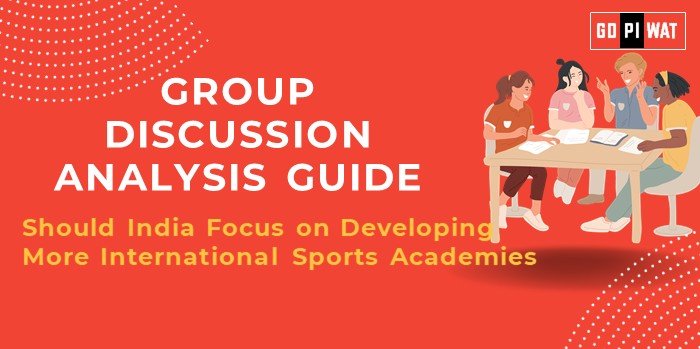📋 Group Discussion Analysis Guide
🏅 Should India Focus on Developing More International Sports Academies?
🌟 Introduction to the Topic
- 📜 Opening Context: “With India’s growing presence in global sports, exemplified by recent successes in cricket, badminton, and athletics, the need for structured international sports academies is evident. Such institutions can propel India from a rising contender to a global sporting powerhouse.”
- 📖 Topic Background: The idea of international sports academies revolves around leveraging global expertise, infrastructure, and methodologies to nurture world-class athletes. While India has seen notable improvements in sports, much of its success still relies on individual brilliance rather than systemic development.
📊 Quick Facts and Key Statistics
- 🏅 India’s Global Sports Rank: Ranked 33rd in the 2024 Olympics medal tally, indicating scope for growth.
- 💰 Government Expenditure on Sports: ₹3,136 crore in 2024, a modest increase from previous years.
- 🏢 Existing Sports Academies: Over 100 national sports centers, but only a handful with global standards.
- 🌍 Athlete Migration for Training: Approximately 25% of elite Indian athletes train abroad, highlighting the domestic gap.
- 💼 Private Sector Role: Corporations like JSW and Reliance have invested significantly in sports infrastructure.
🤝 Stakeholders and Their Roles
- 🏛️ Government: Policy-making, funding, and facilitating partnerships for academy development.
- 💼 Private Sector: Investments in infrastructure and sponsorship programs.
- 🏃 Athletes: Beneficiaries and ambassadors of the initiative.
- 🌍 Global Experts: Coaches and trainers bringing international standards.
- 👥 Local Communities: Grassroots-level identification of talent and inclusivity.
🎯 Achievements and Challenges
✨ Achievements
- 📈 Improved Performance: Steady progress in Olympic sports like javelin throw and badminton.
- 💼 Private Sector Support: Successful initiatives like JSW’s Inspire Institute of Sport.
- 🤝 Global Partnerships: Collaborations with countries like Australia and Germany for athlete training.
⚠️ Challenges
- 🏗️ Infrastructure Gaps: Limited access to world-class facilities across India.
- 🌍 Talent Retention: Athletes migrating to better-equipped nations.
- 📉 Inconsistent Funding: Uneven distribution of resources between sports.
Global Comparisons:
- 🇨🇳 China: Extensive state-backed academies producing Olympic champions.
- 🇺🇸 USA: Private-sector-led sports colleges integrated with education.
Case Study:
- 🥇 Neeraj Chopra: Trained internationally under German coach Klaus Bartonietz, showcasing the impact of global exposure.
🗣️ Structured Arguments for Discussion
- 📈 Supporting Stance: “Establishing international sports academies will bridge the infrastructure gap and create a sustainable pipeline of talent.”
- ⚖️ Opposing Stance: “India must first optimize existing resources before investing in international academies.”
- 💡 Balanced Perspective: “While new academies are essential, equal focus should be on grassroots talent and existing facility optimization.”
💬 Effective Discussion Approaches
- 📌 Opening Approaches:
- “India spends less than 0.1% of GDP on sports, compared to China’s 0.5%.”
- “Athletes like PV Sindhu trained abroad, emphasizing the role of international exposure.”
- 🔄 Counter-Argument Handling:
- “While existing facilities need optimization, international academies can bring global expertise and innovation.”
📈 Strategic Analysis of Strengths and Weaknesses
Strengths:
- 🌍 Rising global recognition.
- 💼 Increasing private-sector participation.
Weaknesses:
- 📉 Inadequate sports budget.
- 🏗️ Urban-rural divide in talent identification.
Opportunities:
- 🏆 Hosting global sports events.
- 👩🎓 Tapping into India’s youth population.
Threats:
- 🏃 Brain drain of athletes.
- 📜 Bureaucratic hurdles in project execution.
🏫 Connecting with B-School Applications
- 📚 Real-World Applications: The topic links to strategy and operations in sports management, talent development, and marketing in global contexts.
- 🎓 Sample Interview Questions:
- “How can India improve its sports policy to attract international attention?”
- “Discuss the role of private-public partnerships in sports infrastructure.”
- 💡 Insights for B-School Students:
- Understanding this issue offers perspectives on leadership, cross-sector collaboration, and global project management.


